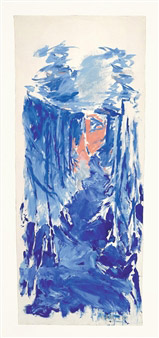Ahrenshoop Museum receives a large-sized original Georg Baselitz on loan from LIVIA Art Investment.
For the exhibition “Signale der Unruhe. Eine Deutsche Begegnung”, which takes place in the Ahrenshoop Museum in Ostseebad Ahrenshoop from November 9, 2014 until January 25, 2015, Prof Dr Dr Löw contributes a large-sized art work (untitled (Teichdamm), 1974, oil on canvas, 209 x 87 cm) from Georg Baselitz (*January 23, 1938 in Baselitz). Following LIVIA’s Art Support Program this is the second work on loan to a Museum this year, following two marble busts from the renowned Italian sculptor Giuseppe Pisani (1757 – 1839), which were exhibited in the Vienna based Albertina Museum from March 13 until June 29, 2014.
The exhibition, dealing with the encounter of West and East Germany during the Cold War, sees the Baselitz painting in the context of rootlessness of the individual during this formative period: ”Vegetation tritt in seiner Kunst dieser Zeit als Gehölz in einer Reihe zeichnerischer Variationen hervor, die alle sehr skizzenhaft aufgefasst und farbig akzentuiert sind: Ganz bewusst wird am Eindruck eines geschlossenen Bildes vorbeigearbeitet. Doch eben dadurch treten die existenzielle Wurzellosigkeit und die daraus sich ableitende schmerzhafte Vorstellung einer hochbrisanten, aber abgetrennten Lebensenergie erst recht hervor. Bäume sind bei Baselitz romantisch in ihrer Gestaltparallele zum menschlichen Körper und sinnbildhaft im Hinblick auf ein (nicht nur das christliche) Martyrium aufgefasst. In der hier gezeigten Arbeit „Teichdamm“ wird das durch den ins Bildzentrum wie ein Herz gesetzten roten Farbfleck verdeutlicht, der mit der auf- oder untergehenden Sonne zugleich den Ort markiert, von dem die Blutströme des Menschen ausgehen und an dem sie sich erneuern.“
Georg Baselitz was born Hans-Georg Kern in 1938 in Deutschbaselitz, in what was later East Germany. In 1956, Baselitz moved to East Berlin, where he studied painting at the Hochschule für Bildende und Angewandte Kunst. After being expelled, he studied from 1957 to 1962 at the Hochschule der Bildenden Künste, West Berlin. During this period, he adopted the surname Baselitz, taken from the name of his birthplace.
Baselitz’s style is interpreted by the Northern American critics as Neo-Expressionist, but from a European perspective, it is more seen as postmodern.
His career excelled in the 1960s after police took action against one of his paintings, (Die große Nacht im Eimer), because of its provocative, offending sexual nature. Baselitz is widely recognized as one of the most influential and important German artists of the post war period.
Since the late 1980s, solo exhibitions and retrospectives of Baselitz’s work have been presented at the Sala d’Arme di Palazzo Vecchio, Florence, in 1988 (traveling to the Hamburger Kunsthalle); Nationalgalerie, Berlin, in 1990; Kunsthaus Zürich in 1990 (traveling to Kunsthalle Düsseldorf); Kunsthalle der Hypo-Kulturstiftung, Munich, in 1992 (traveling to Scottish National Gallery of Modern Art, Edinburgh, and Museum Moderner Kunst, Vienna); Solomon R. Guggenheim Museum, New York, in 1995 (traveling to Los Angeles County Museum of Art; Hirshhorn Museum and Sculpture Garden, Washington, D.C.; and Nationalgalerie, Berlin); Musée d’art Moderne de la Ville de Paris in 1996; Stedelijk Musuem, Amsterdam, in 1999 (traveling to Deutsche Guggenheim Berlin and Hamburger Kunsthalle); and the Royal Academy of Arts, London, in 2007. His solo exhibition at Pinakothek der Moderne in Munich in 2007 featured Baselitz’s recent body of work—the Remix series (begun in 2005) in which the artist conceptualizes anew themes that populated his work in the past. The artist lives in Munich and Imperia, Italy.



